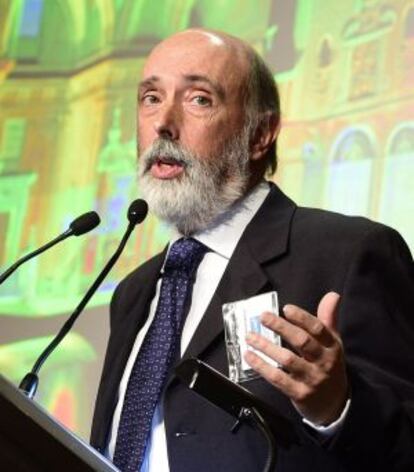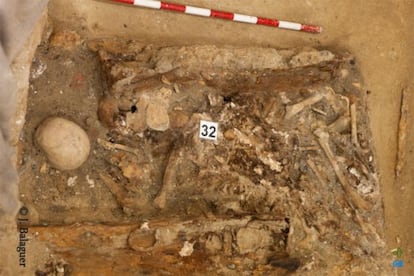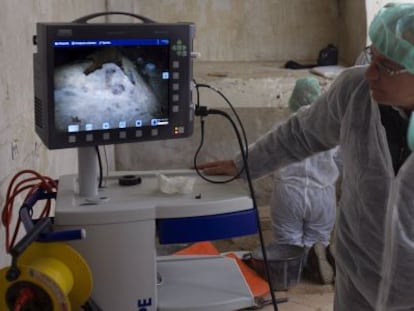“The next step is to obtain a genetic profile of the bones”
Head of team looking for remains of Cervantes talks about the project’s challenges

Francisco Etxeberria is the head of the team searching for the remains of Miguel de Cervantes Saavedra, the author of Don Quixote, in the former Convent of the Barefoot Trinitarians in Madrid’s historic Las Letras area.
A lecturer in Legal Medicine and director of the Aranzadi Scientific Society, Etxeberria has overseen dozens of exhumations, among them victims from both sides in the Spanish Civil War, along with Chilean writer Pablo Neruda and Salvador Allende, the president who died during the military coup led by General Augusto Pinochet in Chile in 1973.
Last week, his team announced that remains found in the convent’s crypt were “possibly” those of the famed author, but that they could not be completely sure, leaving more than a few unanswered questions.
Question. Will you continue to carry out tests on the remains found that are assumed to be those of Cervantes?
Answer. Yes. I will be leading the investigation. The next step is to obtain a genetic profile of the bones attributed to Cervantes, given that, although it is still not possible to compare them, we can conserve them. They have huge potential value.

Q. What is a genetic profile?
A. It’s like a barcode that includes information from parents. This code is unique for each individual. In the case of Miguel de Cervantes, because the remains are in poor condition, we don’t know if we’re going to be able to find that profile after four centuries.
Q. What is needed to be able to carry out this genetic profiling of the remains?
A. We need to use specialist laboratories that are able to reconstruct the genetic sequences that may have been destroyed due to deterioration of the bones. If any of these sequences are repeated then it is possible to reconstruct them. There are laboratories in Spain that can do this, and it’s the only hope to find the genetic sequence. We would also have to carry out biochemical tests on the bones that could provide valuable information.
Q. What scientific value would they have?
A. It would be a fascinating scientific challenge, and one that has precedents, such as the remains of Christopher Columbus, which were tested by one of our team, Miguel Botella, in Granada, where the explorer is buried. Similar tests have also been carried out on the Prince of Viana, in the Poblet monastery.
Q. Is it possible that any more remains of Cervantes are to be found?
A. I do not think so. The remains we have found have been carefully studied, but they still do not allow us to extract any more information.
Q. What about DNA testing?
A. No. That’s not a possibility at this stage.
Q. Are there any other tests you could carry out?
A. Yes. For example, we can reconstruct Cervantes’ face. We have a specialist in this area, Fernando Sarrulla, who works for the Legal Medicine Institute of Galicia. But there hasn’t been the opportunity so far, given that we have not found pathologies in the bones that we know Cervantes had. There is a principle in forensic medicine along the lines of “the fewer the bones, the less said the better.”
It is very strange that only one of the many coffins we have extracted had initials tacked on it”
Q. What approach has your team taken in this investigation?
A. It’s a sequence: first we look at the church, then the crypt, and then niche 32, in the ground, which contained the remains attributable to Cervantes, along with those of 16 other people.
Q. And what did you find in the crypt?
A. We discovered that there were bones mixed together in the wall niche and in the floor. Nobody imagined that there would be further remains in a cellar that already had 36 niches. But over the centuries, the nuns reused the funerary space, which meant that the remains here ended up being mixed together, making our job much harder.
Q. What has been the impact of finding a coffin with the initials MC embossed on it?
A. Our metals expert told us that the tacks used to emboss the initials were not as old as we thought. But I think the tacking was done at a later date by somebody on a new coffin in which the bones had been placed so that they could be identified at a later date. It is very strange that only one of the many coffins we have extracted had initials tacked on it.
Q. What else has the team learned during the investigation?
A. A recognition of the importance of an interdisciplinary approach. One thing is different specialists working on their own areas, but another is a project like ours, where experts exchange information in real time, working together. It is very gratifying to work in this way. Without doubt, the most important thing to emerge here is that this approach will be taught from now on: I have heard already that teachers are discussing with their students the importance of an interdisciplinary approach.
I think the area we have investigated has huge cultural, literary, humanistic, and scientific values”
Q. Will you be leading the next phase?
A. Yes, I will. The key task here is to further develop the different scientific areas outline in the report issued last week, and this will be very important for the future.
Q. What will you do in the next phase of the investigation?
A. This will be purely scientific. Until now we have been through two phases: the first technical, and the second scientific-cultural. Francisco Marín-Perellón, the historian working with us over the last month, has discovered important documents from the 16th century.
Q. Tell us about the plans to turn part of the convent into a museum or cultural center about the Golden Age of Spanish literature.
A. That is not my remit, but in my opinion, I think the area we have investigated has huge cultural, literary, humanistic, and scientific values and should be further developed and investigated.
Q. Have there been any negative aspects to your work here?
A. Yes: people have asked what I have earned from this. I have charged for my travel costs, but I can say that everybody else here has been paid according to the rates established by the state. But their enthusiasm and commitment has no price.
Tu suscripción se está usando en otro dispositivo
¿Quieres añadir otro usuario a tu suscripción?
Si continúas leyendo en este dispositivo, no se podrá leer en el otro.
FlechaTu suscripción se está usando en otro dispositivo y solo puedes acceder a EL PAÍS desde un dispositivo a la vez.
Si quieres compartir tu cuenta, cambia tu suscripción a la modalidad Premium, así podrás añadir otro usuario. Cada uno accederá con su propia cuenta de email, lo que os permitirá personalizar vuestra experiencia en EL PAÍS.
¿Tienes una suscripción de empresa? Accede aquí para contratar más cuentas.
En el caso de no saber quién está usando tu cuenta, te recomendamos cambiar tu contraseña aquí.
Si decides continuar compartiendo tu cuenta, este mensaje se mostrará en tu dispositivo y en el de la otra persona que está usando tu cuenta de forma indefinida, afectando a tu experiencia de lectura. Puedes consultar aquí los términos y condiciones de la suscripción digital.
More information
Últimas noticias
Most viewed
- Pablo Escobar’s hippos: A serious environmental problem, 40 years on
- Reinhard Genzel, Nobel laureate in physics: ‘One-minute videos will never give you the truth’
- Why we lost the habit of sleeping in two segments and how that changed our sense of time
- Charles Dubouloz, mountaineering star, retires at 36 with a farewell tour inspired by Walter Bonatti
- The Florida Keys tourist paradise is besieged by immigration agents: ‘We’ve never seen anything like this’









































